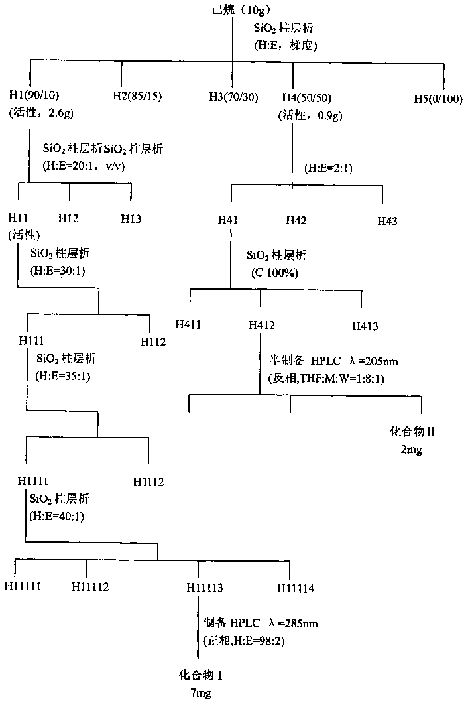An insect repellent isolated from foeniculum vulgare fruit
An insect repellent, fennel technology, applied in the direction of animal repellent, plant growth regulator, biocide, etc., can solve the problem of lack of repellent development and other issues
- Summary
- Abstract
- Description
- Claims
- Application Information
AI Technical Summary
Problems solved by technology
Method used
Image
Examples
Embodiment 1
[0037] Sample preparation and analysis of active compounds
[0038] 13 kg of fennel fruit purchased as a commercial product were dried in an oven at 60° C. for 3 days. The samples were crushed using a blender, and then extracted twice with 100 L of methanol at room temperature for two days. The extract was filtered using Toyo filter paper No2 (Japan), and after filtration, it was concentrated in vacuo at 35° C. to obtain a methanol extract of fennel fruit with a yield of 6%. The yield of methanol extract was calculated by the mass ratio of basic plant fennel fruit to methanol extract. The methanol extract of 780 g was subsequently separated using the polarity and density of the organic solvent, and then 20 g of the methanol extract was separated into n-hexane (18.6 g), chloroform (0.8 g), ethyl acetate (0.1 g), and water-soluble portion (0.5g).
[0039] Experiment 1
[0040] Determine the repelling activity of the methanol extract, hexa...
Embodiment 2
[0051] Separation of the active ingredient in the hexane fraction (720 g) with strong repelling activity
[0052] figure 1 A procedure for isolating the active components of hexane is shown.
[0053] first chromatography
[0054] Hexane chromatography was performed on a silica gel column (Berck 70-230 wells, 600 g, 5.5 i.d. x 70 cm) and gradient elution was performed using a hexane-ethyl acetate elution solution. The ratios of hexane and ethyl acetate used in the gradient solution were 90:10, 85:15, 73:30, 50:50 and 0:100, and a portion of each ratio was collected and named respectively: H1, H2, H3, H4, and H5. The patch test of Experiment 1 was used to test the repelling rate of the five substances to mosquitoes, and as a result, two parts H1 (187g) and H4 (57g) with repelling activity were separated.
[0055] second chromatography
[0056] The active ingredient isolated from the first silica gel chromatography was chromatographed.
[0057] First, H1 was eluted with...
Embodiment 3
[0072] Identification of Active Compounds
[0073] The structure of the active ingredient isolated from Example 2 was confirmed by spectroscopic analysis. Recorded by JNM-LA400F7 spectrometer (TMS as an internal standard) 1 H-and 13 C-NMR spectra and chemical conversions in ppm. Electron impact (EI) UV spectra were obtained from a UV spectrometer (KontronInstrument UVIKON 922) and mass spectra were obtained on a JEOLGSX400 spectrometer. The two active ingredients isolated from Example 2 were fennelone and E-9-octadecenoic acid represented by Chemical Formulas 1 and 2 below.
[0074] [chemical formula 1]
[0075] [chemical formula 2]
PUM
 Login to View More
Login to View More Abstract
Description
Claims
Application Information
 Login to View More
Login to View More - R&D
- Intellectual Property
- Life Sciences
- Materials
- Tech Scout
- Unparalleled Data Quality
- Higher Quality Content
- 60% Fewer Hallucinations
Browse by: Latest US Patents, China's latest patents, Technical Efficacy Thesaurus, Application Domain, Technology Topic, Popular Technical Reports.
© 2025 PatSnap. All rights reserved.Legal|Privacy policy|Modern Slavery Act Transparency Statement|Sitemap|About US| Contact US: help@patsnap.com


